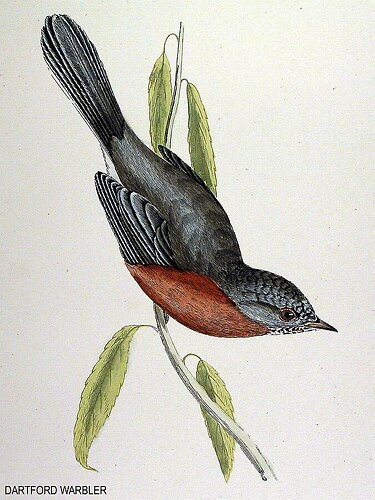The small, dark, long-tailed warbler is resident in the UK and has recently extended its range in southern England.
The species has suffered from severe winters winters in the past and its population crashed to maybe only a dozen pairs in the bitter winter of 1962/3. A succession of mild winters has made a gradual recovery both in numbers and range possible.
A shy species, ocassionally seen singing while perched on a stem of gorse, it is more often seen bobbing between the bushes of its scrub habitat.
Britain lies on the northern edge of this warbler's European range and it occurs only in southern England, the bulk of the population found from Dorset to Sussex with small numbers in Devon and Cornwall and on the Isle of Wight.
Some wandering may occur in winter when occasional birds are seen as far afield as East Anglia.
|
It seems to be a rare bird in this country, and owes its name, with us, to the accident of a pair of them having been seen near Dartford, in Kent, some years ago; they have since been observed in great numbers, and are supposed sometimes to winter with us.
| |
| - Bewick's British Birds, Vol. I: The Dartford Warbler, 1797 |
In Britain, the Dartford Warbler breeds in dry scrub
(heather and gorse), in Southern Europe it breeds in maquis.
| | | | kingdom | Animalia | | phylum | Craniata | | class | Aves Birds | | order | Passeriformes | | family | Sylviidae | | genus | Sylvia | | species | Sylvia undata |
|
| | | Links to Other Pages on This Site
|
| |
| | |
|
| | | Links to Other Sites
|
| |
| | |
|
| | | Links to Other Pages on this Site
| CORNWALL |
| |
| | The species is restricted to the south-eastern part of the county. |
| | |
| DEVON |
| RSPB Reserve, Aylesbeare |
| | |
| Dartmoor National Park |
| | Having recently expanded its range across southern Britain to include Dartmoor, the 50 or so pairs which nest in the park are a nationally significant population. |
| | |
| HAMPSHIRE |
| New Forest |
| | The New Forest is home to the largest and possibly most important population of Dartford Warblers in Britain. It is believed this population acts as a reservoir from which other areas can be recolonised following adverse winters. |
| | |
| SUFFOLK |
| |
| | Never a plentiful species this far north and with no old records of breeding in the county, it lingered in Suffolk until at least the late 1920s and has now returned as a breeding bird. |
| RSPB Reserve, Dunwich Heath |
| | |
| RSPB Reserve, North Warren |
| | |
| | |
|
| |
| | |
Warblers of Europe, Asia and North Africa
by K Baker, publisher Christopher Helm
Sylvia Warblers
by H Shirihai, G Gargallo and A Helbig, publisher Christopher Helm
Recommend a Book for this Page
Hits on this page since December 6th| Jan | | |  | | 7 | | Feb | | |  | | 2 | | Mar | | |  | | 1 | | Apr | | | | | | | May | | |  | | 3 | | Jun | | | | | | | Jul | | | | | | | Aug | | | | | | | Sep | | | | | | | Oct | | | | | | | Nov | | | | | | | Dec | | |  | | |
current year:  | | previous year:  |
DISCLAIMER: Whilst we endeavour to ensure the content of this site is correct, we cannot undertake that information you find here, is, or will remain accurate and complete. We do not warrant that any information contained on this site is fit for any purpose. If you wish to place reliance on any such information you must check its accuracy by some other means before doing so. If you are in any way connected with any location mentioned on this site or have an interest in any of its contents and have an hour or two a month to spare, we would welcome you as a local moderator - please email the webmaster by CLICKING HERE. Privacy Policy
|
|









